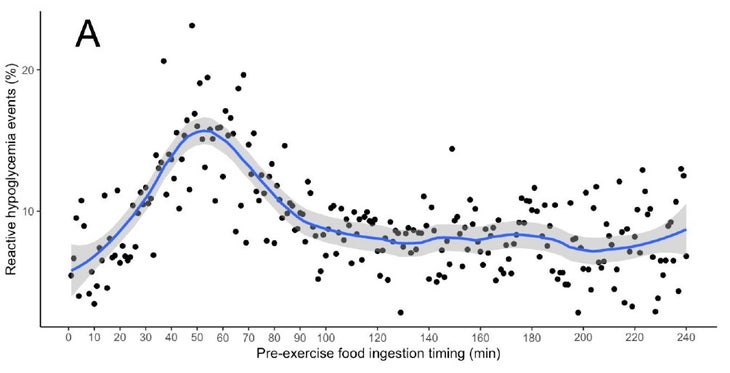How to Optimize Your Pre-Workout Meal Timing

“], “filter”: { “nextExceptions”: “img, blockquote, div”, “nextContainsExceptions”: “img, blockquote, a.btn, a.o-button”} }”>
New perk! Get after it with native options just for you. Uncover shut by events, routes out your door, and hidden gems whilst you
>”,”establish”:”in-content-cta”,”form”:”hyperlink”}}”>be part of the Native Working Drop.
There are two parallel agendas in a model new paper from the science workforce at Supersapiens, the company promoting regular glucose shows for endurance athletes. The plain one is to unravel quite a few the mysteries surrounding rebound hypoglycemia, a plunge in blood sugar that afflicts some people after they eat too close to a train. The underlying one is to point that sticking CGMs, which had been initially developed as medical items for managing diabetes, on a whole bunch of utterly healthful athletes yields some useful insights that we wouldn’t be succesful to pay money for in every other case. Every targets are fascinating—on the very least to me, provided that I’ve expert occasional bouts of rebound hypoglycemia for as long as I can bear in mind.
The preliminary pitch from Supersapiens was {{that a}} CGM could carry out as a “real-time gasoline gauge” to hint ranges of glucose (i.e. sugar) throughout the bloodstream. I dug into the details of this declare on this 2021 articlenonetheless the vital factor degree is that glucose ranges are far tougher than the gasoline dial in your vehicle. Prepare burns glucose, nonetheless triggers the liver to dump further into circulation. Consuming carbs raises glucose ranges, nonetheless triggers insulin that strikes glucose once more out of the bloodstream and into muscle and fat cells for storage. There are a whole bunch of alerts and countersignals attempting to keep up roughly a teaspoon of glucose in circulation at all times.
Sometimes these alerts get crossed. While you eat a bowl of oatmeal throughout the morning, your blood sugar will most likely rise. In response, you’ll secrete insulin to get the levels once more to common. Nonetheless the insulin spike doesn’t take influence immediately; it gained’t peak for 45 to 60 minutes. Within the meantime, for individuals who head out for a run, your muscle tissue will start burning by means of glucose as lots as 100 situations prior to they do at leisure. While you time it badly, the insulin will kick in merely as your muscle tissue start demanding further glucose, and the two outcomes collectively will set off your ranges to overshoot and produce a blood-sugar low. That rebound hypoglycemia (or reactive hypoglycemia, as a result of it’s moreover recognized) might make you are feeling dizzy, light-headed, and weak.
RELATED: Ask The RDN: How To Not Screw Up Your Pre-Race Breakfast
The on a regular basis suggestion for dealing with rebound hypoglycemia is to stay away from consuming between about 30 and 90 minutes sooner than prepare, and considerably to stay away from high-carb and high-glycemic-index meals. Supersapiens makes the app used with Abbott’s Libre Sense Glucose Sport Biosensor, so it has entry to a large database of anonymized data collected by its clients. It’s a pretty unusual trove, on account of scientists throughout the pre-CGM interval didn’t spend a great deal of time measuring glucose ranges in people with out diabetes. As soon as I spoke to a couple of Supersapiens’ scientists once more in 2021, that they had been struggling to stipulate what sorts of glucose readings must be considered purple flags, on account of no one was completely sure what was common for endurance athletes. The model new analysis, printed in the European Journal of Sport Science by a workforce led by Andrea Zignoli of Supersapiens and the Faculty of Trento in Italy, is especially a proof of principle displaying that this massive database has some worthwhile courses to point out us.
The analysis itself is fairly straightforward. They analyzed nearly 49,000 events from 6,700 clients by which someone ate one factor after which exercised. The vital factor variables had been how prolonged sooner than prepare they ate, and whether or not or not their glucose ranges dipped beneath 70 mg/dL in the midst of the primary half-hour of prepare. That’s an arbitrary threshold for rebound hypoglycemia, and in actuality there doesn’t look like a relentless threshold that produces harmful indicators in a number of people. Scientists aren’t even sure whether or not or not it’s completely the diploma of glucose that points, or the pace at which it’s dropping, or one other combination. Nonetheless 70 mg/dL is a reasonable benchmark that signifies that your blood sugar ranges dropped significantly larger than you’d depend on.
The first question they considered is how prevalent rebound hypoglycemia is. It’s a powerful one to quantify, on account of nearly everyone will get low blood sugar all through workout routines typically (even after they don’t experience indicators), and no one will get it every time they work out. While you experience it in further than 20 % of your workout routines, it’s most likely trustworthy to say that you just simply’re susceptible to it. About 15 % of the Supersapiens clients met this threshold.
As for meal timing, proper right here’s a graph that reveals what amount of workout routines produced a blood-sugar low (on the vertical axis), as a carry out of time as a result of the ultimate meal (on the horizontal axis):

There’s a fairly obvious bump there, peaking at about 50 minutes sooner than the train. That’s whilst you’re greater than doubtless to offer your self rebound hypoglycemia, and the possibility is elevated to your full interval between about 30 and 90 minutes prior.
So there it is! Enormous data from a whole bunch of CGM clients reveals us what we already type of knew. To be trustworthy, they do some further data-crunching. By their calculations, spherical 86 % of people aren’t susceptible to rebound hypoglycemia the least bit. Eight % are susceptible, nonetheless can cut back their menace by adjusting the timing of their pre-workout meal. And the ultimate six % are susceptible, nonetheless meal timing doesn’t seem to make a distinction for them. That’s a useful, if depressing, new notion for a lot of who happen to fall into the ultimate group.
As for the bigger picture—the idea we’ll be taught useful points by having endurance athletes placed on CGMs—it’s faraway from a slam dunk, nonetheless I really feel it’s a good start. There’s an prolonged, prolonged guidelines of sports activities actions science units that will plausibly declare that they may give us useful knowledge. Nonetheless only some of them observe by means of with the laborious slogging required to validate these claims. Confirming that there’s a pre-workout meal-timing window for rebound hypoglycemia doesn’t truly switch the needle, and to get deeper insights Supersapiens goes to ought to persuade a subset of its clients to keep up truly right meal and train knowledge. It gained’t be easy, nonetheless I’m already curious to see what they’ll provide you with subsequent.
For further Sweat Science, be a part of me on Twitter and Fbbe part of the e mail e-newsletterand try my information Endure: Ideas, Physique, and the Curiously Elastic Limits of Human Effectivity.





